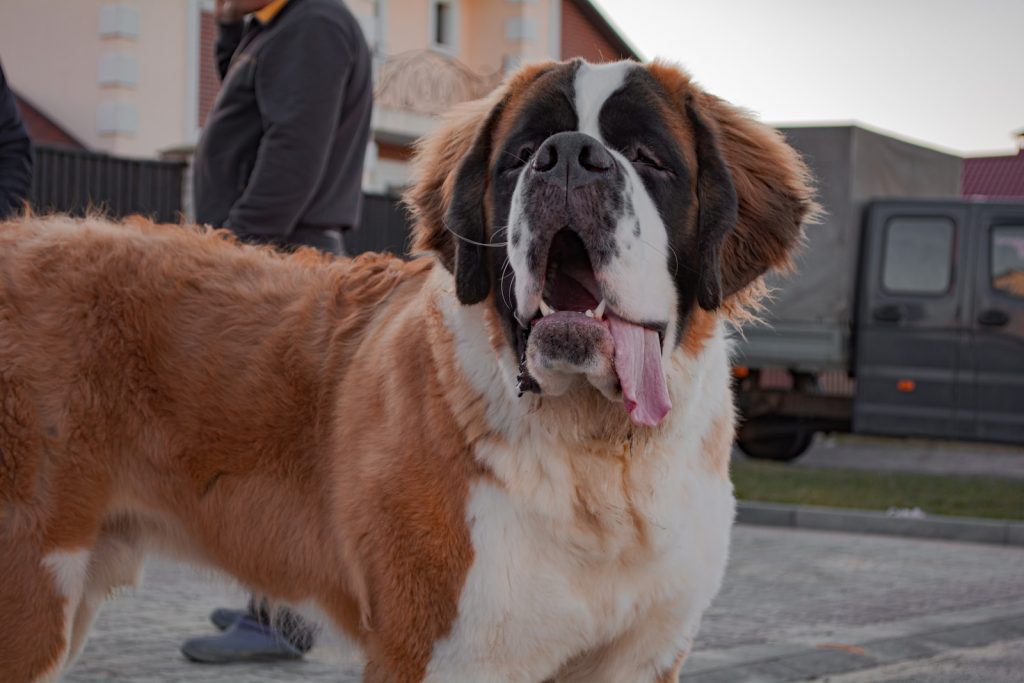The Saint Bernard breed is a remarkable example of strength, intelligence, and loyalty. Originally bred for rescue missions in the Swiss Alps, these dogs have a rich history of serving others and have become beloved family pets. With their muscular build and thick coat, they are a striking sight that captures the hearts of many dog lovers.
As a working breed in the Mastiff family, this breed have a reputation for being highly intelligent and trainable. Their impressive size and strength make them ideal for various tasks, from search and rescue missions to guarding and protecting their families. Despite their imposing appearance, they are gentle and affectionate with their loved ones, making them cherished companions.
In this article, we will explore the physical characteristics, history, temperament, and upkeep of the strong and intelligent Saint Bernard breed.
Key Takeaways
- Saint Bernards were originally bred for rescue missions in the Swiss Alps and are known for their intelligence, loyalty, and strength.
- They have a powerful and tall build, with a weight range of 120-180 pounds and a height of 25 to 30 inches.
- Saint Bernards have two variations of coat, which require regular grooming to keep healthy and shiny.
- They are highly intelligent and trainable, ideal for various tasks, from search and rescue missions to guarding and protecting their families. They are also known for their gentle and affectionate temperament, making them great with children and other pets.
Origin of the Breed
This breed has a fascinating history rooted in the Swiss Alps. Initially bred by monks at the Saint Bernard Hospice, these dogs served as invaluable companions and rescuers for lost travelers in the treacherous mountain passes. With their keen sense of direction and ability to locate stranded individuals in the snow, Saint Bernards gained legendary status as mountain rescuers.
Appearance and Size
Saint Bernards are instantly recognizable due to their imposing size and distinctive facial features. They have a powerful, muscular build with a broad chest and a deep, wide skull. Their expressive eyes are usually dark and gentle, conveying their friendly and approachable nature.
On average, male Saint Bernards stand between 27 to 30 inches (68 to 76 cm) tall at the shoulder and weigh between 140 to 180 pounds (64 to 82 kg). Females are slightly smaller, typically measuring 25 to 28 inches (64 to 71 cm) in height and weighing between 120 to 140 pounds (54 to 64 kg).
One of the defining features of this breed is its thick and weather-resistant coat. They come in two coat types: smooth and rough. The smooth variety has short, dense fur, while the rough variety has a longer and coarser coat. Saint Bernards commonly exhibit a combination of white with markings in various shades of red or brindle.
Temperament and Personality
One of the most endearing qualities of Saint Bernards is their gentle and friendly temperament. They are renowned for their patience, tolerance, and devotion to their families. Saint Bernards are excellent with children and make wonderful family pets due to their calm and easygoing nature.
Despite their imposing size, they are not typically aggressive. They are more likely to shower you with slobbery kisses and lean against you for affection. Their inherent nurturing instinct makes them great companions for both humans and other animals.
Caring for a Saint Bernard
Owning a Saint Bernard is a rewarding experience, but it also comes with responsibilities. Let’s explore the various aspects of caring for these gentle giants, from feeding and grooming to exercise and health considerations.
Feeding and Nutrition
To keep your Saint Bernard healthy and thriving, it’s crucial to provide them with a well-balanced diet that meets their nutritional needs. A high-quality dog food formulated for large breeds is recommended to support their growth and overall health. Consult with your veterinarian to determine the appropriate feeding regimen for your Saint Bernard based on their age, weight, and activity level.
Grooming Requirements
Brushing and Bathing
They have a thick double coat that requires regular brushing to prevent matting and remove loose fur. They shed moderately throughout the year and experience heavier shedding during seasonal changes. Bathing should be done as needed to keep their coat clean and free of dirt.
Nail Trimming and Ear Cleaning
Trimming your pup’s nails is essential to prevent overgrowth and potential discomfort. Their ears, which hang down, should be checked regularly for dirt, debris, or signs of infection. Cleaning their ears with a gentle ear cleaner recommended by a veterinarian helps maintain their ear health.
Training and Exercise
Socialization and Obedience Training
Early socialization is crucial for Saint Bernards to develop into well-rounded dogs. Exposing them to different people, animals, and environments from a young age helps them become confident and well-behaved adults. Obedience training is also essential, as their large size requires them to be well-mannered and responsive to commands.
Exercise Needs
While they are not overly active, they still require regular exercise to keep them fit and mentally stimulated. Daily walks, playtime, and interactive activities are beneficial for their physical and mental well-being. However, it’s important to avoid excessive exercise in hot weather due to their predisposition to heat-related issues.
Health Considerations
Common Health Issues
Like all dog breeds, they are prone to certain health conditions. Being aware of these potential issues can help you provide proactive care and seek early veterinary intervention when necessary. Some common health concerns in Saint Bernards include:
- Hip and Elbow Dysplasia: This condition occurs when the joints don’t develop properly, leading to pain and mobility issues.
- Gastric Dilatation-Volvulus (GDV): Also known as bloat, GDV is a life-threatening condition that affects deep-chested breeds, including Saint Bernards. It involves twisting the stomach, which can cut off blood supply and cause severe complications.
- Cardiac Conditions: Saint Bernards are predisposed to certain heart conditions, such as dilated cardiomyopathy (DCM) and subaortic stenosis (SAS). Regular cardiac evaluations are recommended to monitor their heart health.
- Ectropion and Entropion: These eyelid abnormalities can lead to eye irritation and infections. Regular eye care and veterinary check-ups are essential to address these issues.
Lifespan
On average, Saint Bernards have a lifespan of 8 to 10 years. However, with proper care, some individuals have been known to live beyond 10 years. Providing a nutritious diet, regular exercise, and routine veterinary care can contribute to a longer and healthier life for your beloved Saint Bernard.
Regular vet check-ups, a balanced diet, and providing a safe and stimulating environment are essential components of maintaining the health and well-being of your Saint Bernard.
Saint Bernards as Family Pets
Compatibility with Children and Other Pets
Saint Bernards are known for their gentle and patient nature, making them excellent companions for children. They are generally tolerant of other pets in the household and can get along well with cats and other dogs when properly introduced and socialized.
Living Arrangements
Due to their large size, Saint Bernards require ample space to move around comfortably. They are well-suited to homes with yards or access to outdoor areas where they can explore and stretch their legs. However, they also thrive in homes with loving families who provide them with the attention and affection they crave.
Famous Saint Bernards
Throughout history and popular culture, Saint Bernards have left their pawprints. The most famous Saint Bernard, “Barry,” is credited with saving the lives of over 40 people in the Swiss Alps during the early 1800s. Additionally, the eponymous movie franchise’s fictional character “Beethoven” has brought further recognition to this remarkable breed.
Frequently Asked Questions (FAQs)
- Are Saint Bernards good with children?
- Absolutely! This breed is known for their gentle and patient nature, making them excellent companions for children. However, supervision is always recommended to ensure the safety of both the dog and the child.
- Do Saint Bernards drool excessively?
- Yes, this breed is notorious for its slobber. They have loose jowls and produce a fair amount of drool, especially after eating or drinking. Keeping a towel handy and regular mouth cleaning can help manage the drool.
- Are Saint Bernards easy to train?
- While they are intelligent and eager to please, they can sometimes be a bit stubborn. Early socialization and consistent positive reinforcement training methods work best for this breed.
- Can Saint Bernards adapt to apartment living?
- Due to their large size and exercise needs, this breed is better suited for homes with ample indoor and outdoor space. However, they can adapt to apartment living with regular exercise and mental stimulation, provided they receive sufficient activity.
- Do Saint Bernards require a lot of grooming?
- Their thick double coat requires regular brushing to keep it clean and free from mats. They also shed moderately, so be prepared for some hair around the house.
- Are Saint Bernards good guard dogs?
- Saint Bernards are typically friendly and welcoming to strangers. While their size alone can be intimidating, they are not known for being aggressive guard dogs. They are more likely to greet intruders with a wagging tail than to act aggressively.
Conclusion
The Saint Bernard breed a combination of strength and gentleness, making them exceptional companions. Whether it is their prominent role as courageous rescue dogs or their unwavering loyalty as beloved family pets, these majestic giants have captured the hearts of dog enthusiasts worldwide. However, it is essential to bear in mind that owning a Saint Bernard entails responsibilities, such as providing proper care and training and addressing their specific health requirements.
If you are passionate about finding forever homes for stray and unwanted dogs in Mexico and helping them find loving families in Canada or the US, Bone Voyage Dog Rescue is dedicated to making that a reality. They are committed to rescuing and rehoming these deserving dogs, and your support can make a significant difference. Whether you volunteer your time, offer foster care, or donate, you can actively contribute to Bone Voyage Dog Rescue’s mission of giving these dogs a second chance.
To discover more ways to help, please contact Bone Voyage Dog Rescue at [email protected] or call us at +52 3329718011. We can create a brighter future for these wonderful Saint Bernards and other needy dogs. Let’s unite and impact their lives, ensuring they receive the love and care they truly deserve.



